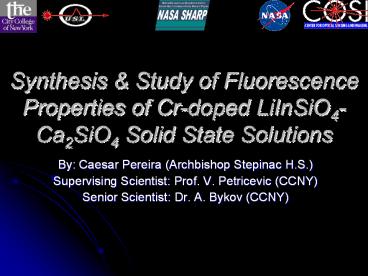Synthesis - PowerPoint PPT Presentation
1 / 17
Title:
Synthesis
Description:
Synthesis & Study of Fluorescence Properties of Cr-doped LiInSiO4-Ca2SiO4 Solid State Solutions By: Caesar Pereira (Archbishop Stepinac H.S.) Supervising Scientist ... – PowerPoint PPT presentation
Number of Views:62
Avg rating:3.0/5.0
Title: Synthesis
1
Synthesis Study of Fluorescence Properties of
Cr-doped LiInSiO4-Ca2SiO4 Solid State Solutions
- By Caesar Pereira (Archbishop Stepinac H.S.)
- Supervising Scientist Prof. V. Petricevic (CCNY)
- Senior Scientist Dr. A. Bykov (CCNY)
2
Background
- The goal of my research is to develop the most
effective crystallites for near-infrared optical
amplifiers using the Cr4 ion - This research will aid in the development of new
and more effective lasing media. - The results will bring a deeper understanding of
the different olivine structures optical
properties, such as fluorescence.
3
What are LASERs?
- LASER is an acronym for Light Amplification by
Stimulated Emission of Radiation - When a laser ion is pumped with energy, its
electrons move to a higher energy level - The electrons after being excited will
spontaneously fall back to the ground state - At this moment spontaneous light emission
occurs. This is called fluorescence.
4
Laser Properties
- Monochromatic
- It contains one specific wavelength of light (one
color) - Coherent
- Each photon moves in phase
with each other (organized) - Directional
- A laser light has a highly focused tight beam and
is very strong and concentrated
5
Solid-State Lasers
- Although the amplifying media can be solid,
liquid, or gas, we chose to use solid-state media
for our research, such as crystals - In my project, the amplifying medium is a crystal
containing Cr4 ions as dopands. - The reason crystals are different colors is
because the electron configuration of the ion
determines what color we perceive. - In our samples the electron configuration of the
Cr4 ion appears to be the color green.
6
History
- Previous research in this project revealed the
optimal amount of CrO2 to be used in an olivine
crystallite structure is between 0.5 and 0.1 of
the total weight. - The Cr4 ion is the desired valence state for Cr
because its fluorescence is greater than the Cr3
ion and also it encompasses a larger range of
wavelengths in the near-infrared region we are
investigating.
7
Abstract
- The goal of my project, now, is to find the best
suitable host for the Cr4 ion by combining the
elements calcium, lithium, indium, silicon, and
oxygen to achieve the optimal Host crystal
structure, in particular of LixInxCaySiO4. These
compounds will be combined in different
concentrations to find which mixture gives the
desired fluorescence. The crystals obtained from
this research will be effective amplifying media
for use in optical fiber communications, remote
sensing and other photonics applications.
8
Materials
- The following compounds are being studied as host
materials indium oxide
(In2O3), lithium carbonate (Li2CO3), silicon
oxide (SiO3), and calcium oxide (CaO2) with
chromium oxide (Cr2O3) as the dopand - Temperature-Controlled Furnace
- Electronic Scale
- Mortars
- Crucibles
- Round paper
- Fluorescence setup
9
Methods
- Before preparing the powders, stoichiometry was
used to calculate the weights of each of the
compounds - After weighing out each compound carefully on a
very precise scale, the compounds were mixed in a
mortar - Ethanol was added to each powder to make it
homogeneous (uniform) but later on evaporated out
under a fume hood so as not to change the
properties of our compounds
10
Methods (continued)
- The compounds underwent long periods of heating
in the furnace 24 hours. - Each powder was heated at 1100C to obtain the
Cr4 ions needed for our crystal synthesis - Eight different mixtures were made
- The difference between each mixture was how much
lithium, indium, and calcium each one contained
11
Compounds Used
- Place chart here
12
Characterization of Fluorescence
13
Cr4 Sample Fluorescence Readings after 1100ºC
- Under Construction
14
Results
- Further analysis required
15
Acknowledgements
- Mentors Dr. Bykov Prof. Petricevic
- NASA SHARP / NYCRI
- NASA COSI DoD NPC Summer Program
- City College of New York
- CREST-CMMS
- NYC-MTA
16
References
- "The Causes of Color," K. Nassau, Scientific
American, Volume 243, Number 4, October1980, pp.
124-154. - Introduction in optical properties measurements
of laser crystals Introduction in absorption
measurements, A. Bykov. - Illustrations http//www.howstuffworks.com
- Source 4
- Source 5
- Source 6
- Source 7
17
The End































